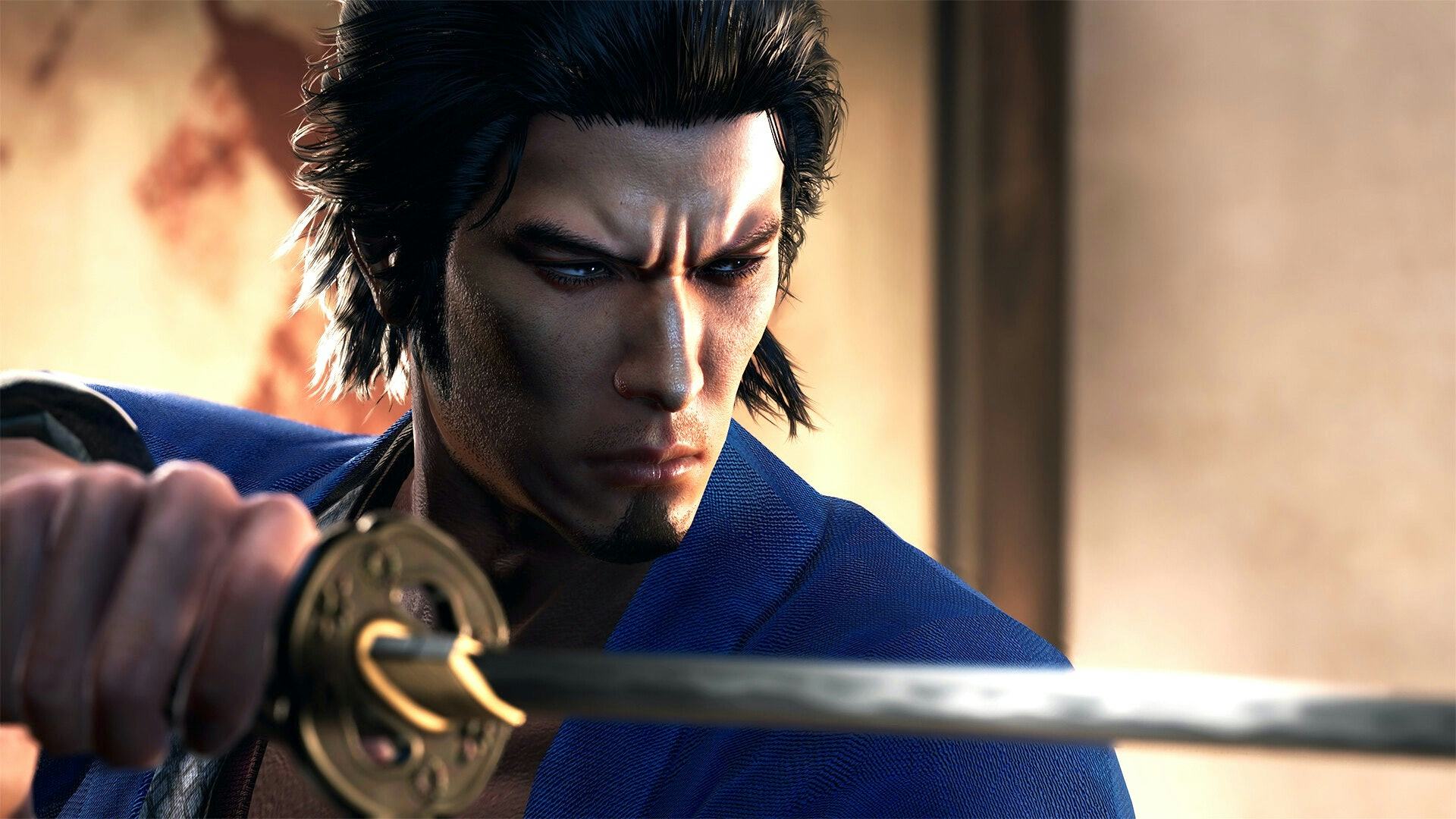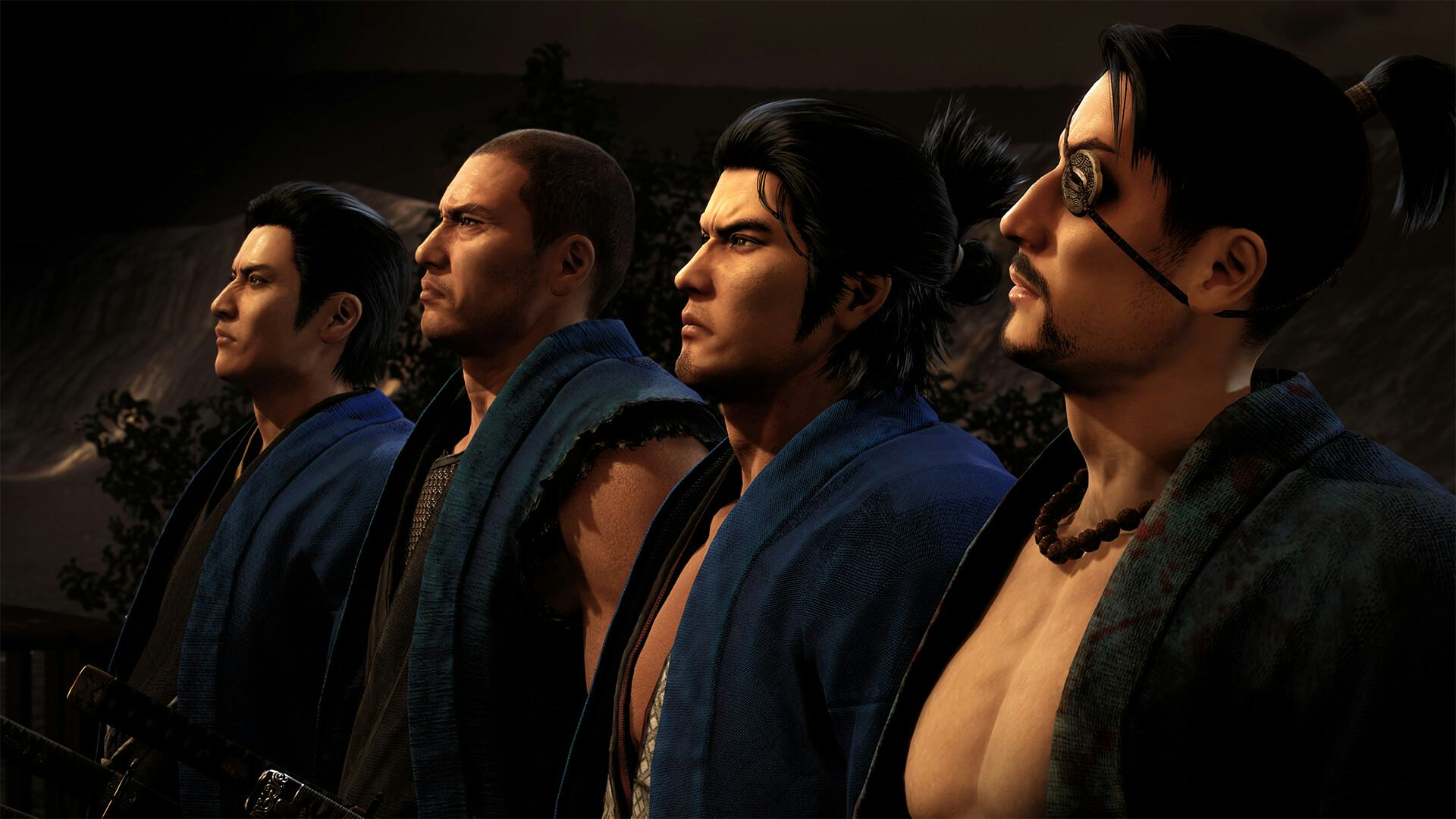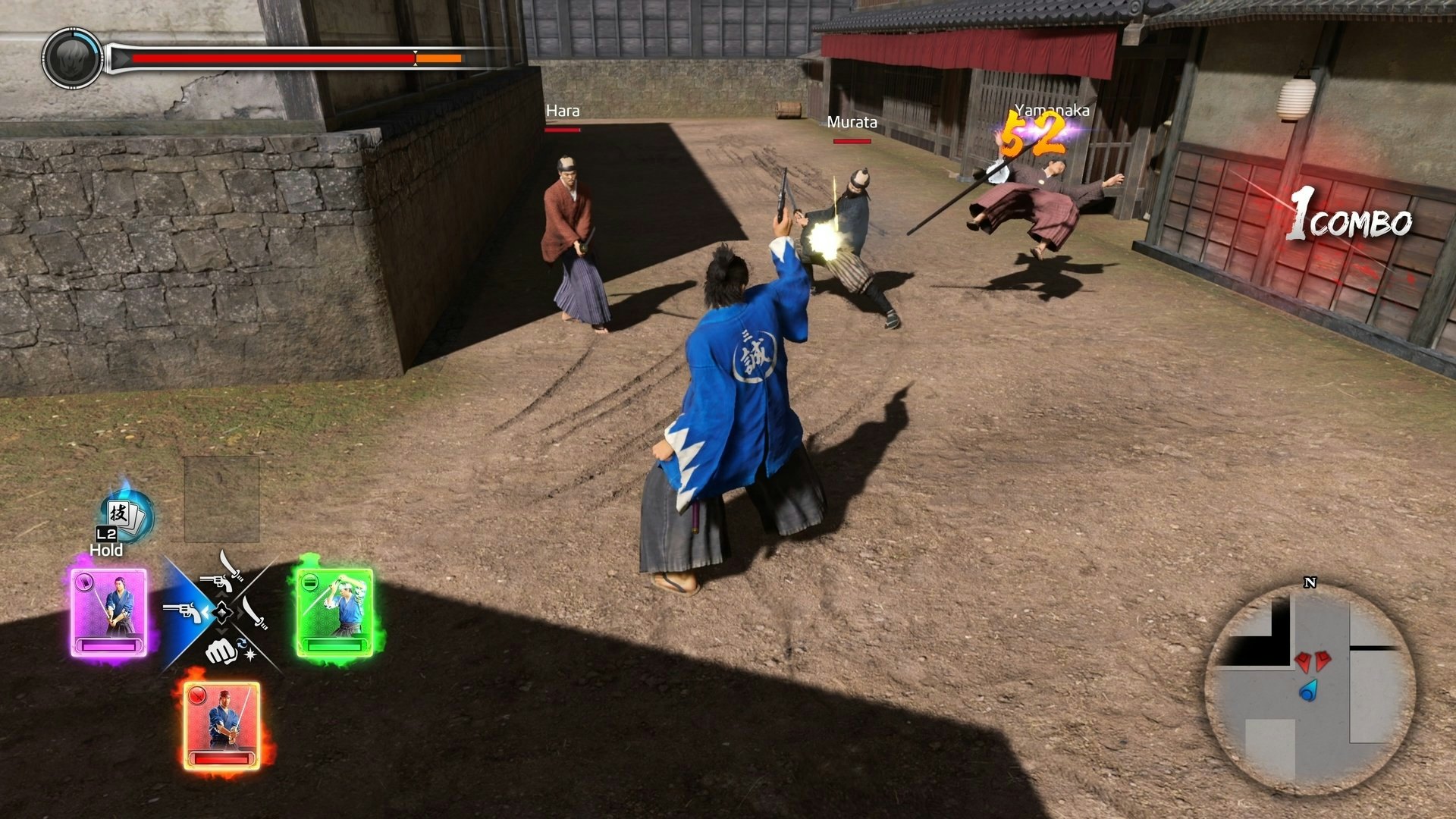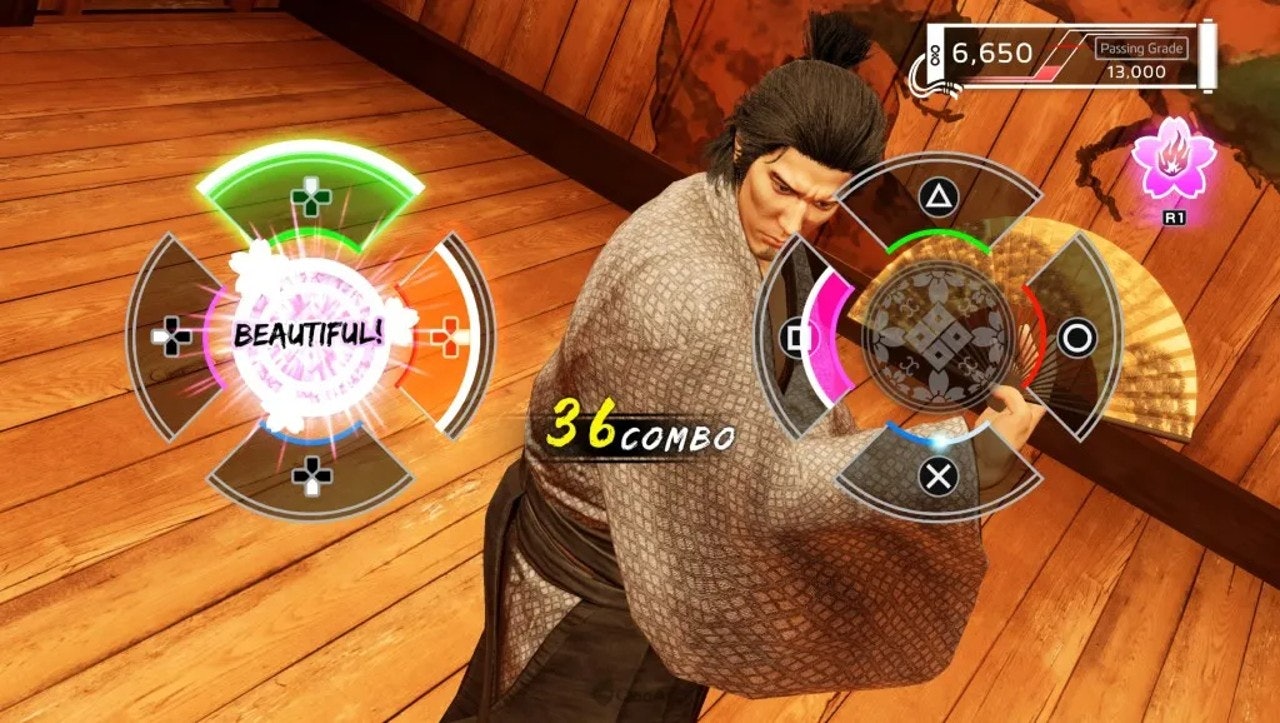
The town of Kyo is filled with all of my favorite friends, from “Vegetable Boy” who whines that his mom only feeds him tofu to a filthy cat that repeatedly falls in the mud.
Like a Dragon: Ishin absolutely revels in the Yakuza series’ weirdo humor, but that’s only one half of the equation. There’s also a genuinely dramatic samurai story sizzling with tension. Ishin has some of the best storytelling the series has ever seen. The only thing holding it back is a convoluted combat system that takes a while to find its groove.
Playing With History
Ishin fills a strange place in the Yakuza series, which now goes by “Like a Dragon.” The game was released in Japan back in 2014, but it didn’t receive a Western port until now. Developer Ryu Ga Gotoku long feared that Western fans would struggle with a narrative that focuses so heavily on Japanese history. Times have changed, of course.

Like a Dragon: Ishin tells the story of Sakamoto Ryoma, a real-life samurai that lived during the Bakumatsu Period (1853-1867) of Japan. After training in Edo, he returns to his homeland of Tosa only to find his adoptive father and brother in the initial stages of a rebellion. Before long, Ryoma finds himself smack dab in the middle of assassinations, conspiracies, and a battle for the future of Japan. Ishin’s story is stacked with twists and turns, but there’s a surprisingly methodical pacing to the entire affair.
There are certainly high-octane moments, but Ishin’s story slowly builds up to a massive thrilling climax, and the result is a story that has a ton of payoff for its well-written characters. There are tons of terms and concepts from the Bakumatsu period and Japanese history, but the game has a lengthy codex with explanations that can help keep players up to speed.
Perhaps the most fascinating thing about Ishin is that it ultimately feels like a period drama where the characters are all played by your favorite Yakuza characters. This is a full-fledged spinoff, but the characters all feel like reflections of their selves from the main series. Ryoma shares a lot of Kazuma Kiryu’s morals and tendencies, but he’s a bit sharper and more willing to use violence to meet his goals. By the same token, Okita Soji shares Goro Majima’s penchant for murder but with an interesting intellectual edge as well. Each voice actor gives an excellent melodramatic performance. Fans of the series will delight in seeing how these characters differ from their Yakuza counterparts.
Heating Things Up

While recent games in the franchise have moved to turn-based combat, Like a Dragon: Ishin returns to the classic beat-em-up formula, providing players with four distinct combat “styles” like in Yakuza 0. Ryoma can assume the style of a bare-handed Brawler, a melee-focused Swordsman, a ranged Gunman, and Wild Dancer, which is a speedy style that lets you wield a sword and gun at the same time.
While entertaining in its own right, the combat has a certain degree of jank, serving as a constant reminder that this is essentially a remaster of a 2014 game. It simply lacks a lot of the fluidity and polish found in later entries like Yakuza 6: The Song of Life. It all feels a bit choppier than it should be, but the bigger problem comes when you factor in Ryoma’s equipment and stats.
Each of the four styles earns experience independently, while you also have an overall level. Each level, both overall and of each style, awards a Soul Orb that you can slot into an ability grid to earn new moves, level up the style, and more. Apart from that, Ryoma can equip a sword, gun, and three pieces of equipment.

Progression winds up feeling like a needlessly complicated affair, and it takes ages to unlock the more useful abilities or access new equipment. The game also constantly throws side quests that are far more challenging than the main story, and these difficulty spikes really jeopardize your enjoyment of the experience. Once you get to some of the later abilities for your styles the combat drastically improves, but even simple moves like launching an attack right after a dodge are likely going to be locked out for hours.
Side-Questing Samurai
This iteration of Ishin introduces a new Trooper Cards system that adds some additional hilarious flair to combat. Once Ryoma joins the Shinsengumi he’ll unlock character cards that can be used during combat. Each style can equip a different set of cards, and these cards charge during combat and can provide a wide array of effects. One might boost the damage of the style you have equipped, while another summons an adorable dog that distracts all enemies in combat. Trooper Cards make your combat options feel even more dynamic, and it’s something that’s a welcome addition.
While it’s a shame that combat takes so long to find its groove, Ishin’s side content more than makes up for it. Ishin has some of the best substories and minigames this series has ever seen thanks in no small part to a “friendship” system that tracks your relationships with the various residents of Kyo. In his travels, Ryoma nurtures relationships with dozens of NPCs, from restaurant or shop owners to random strangers that roam the streets. Your bond increases over time with various interactions. Do it enough and it might unlock additional stories, useful rewards, or ties into an important system known as Virtue.

Virtue is a currency that runs throughout the entire game, and you’re awarded it for pretty much everything, including eating at restaurants, shopping, completing substories, and a variety of challenges called Diligence Records. You can spend Virtue at shrines to unlock new features like increasing your sprinting speed.
It’s strange that Ishin’s progression for combat abilities feels so sluggish, as the progression tied to Virtue feels constantly rewarding. As you get to know the people of Kyo and see some fun side stories you’re constantly gaining points, which in turn opens up new aspects of the world. The whole system feels great, I just wish the other progression aspects of the game could match it.
The various stories you experience in side-quests strike that humorous and heartfelt balance Yakuza excels at. One sees Ryoma playing the wife in a game of house with some kids, while another has him teaching an American to be a samurai, who’s dressed in a jaw-dropping star-spangled banner Haori. Then you have the Another Life section that sees Ryoma meeting up with an Ishin version of Haruka, his adopted daughter from the main games, and gives you the ability to run a quaint little farm and cook meals to your heart’s content.

There’s an almost overwhelming amount of things to do, between substories, mini-games, friendships, and more, but Ishin does a good job of layering it all in across the story. More importantly, you can choose to pursue as much or as little as you want, at any time. There’s never pressure to break away from the main story, even though a lot of the little self-contained stories are where the real emotional storytelling lies.
What surprises me most about Like a Dragon: Ishin is how much it stands out from the rest of the franchise even though the core formula remains the same. The historical samurai theme seeps into every aspect of the game and gives Ishin a unique flair all its own, from the music that mixes traditional music with hard rock to the superbly directed cinematic scenes that just ooze with tension. It’s a wildly imaginative spinoff that perfectly captures the absurd blend of drama and weirdness Yakuza has built its name on.
9/10
Like a Dragon: Ishin launches on February 21 for PS4, PS5, Xbox One, Xbox Series X|S, and PC. Inverse reviewed the PS5 version.
INVERSE VIDEO GAME REVIEW ETHOS: Every Inverse video game review answers two questions: Is this game worth your time? Are you getting what you pay for? We have no tolerance for endless fetch quests, clunky mechanics, or bugs that dilute the experience. We care deeply about a game’s design, world-building, character arcs, and storytelling. Inverse will never punch down, but we aren’t afraid to punch up. We love magic and science-fiction in equal measure, and as much as we love experiencing rich stories and worlds through games, we won’t ignore the real-world context in which those games are made.







